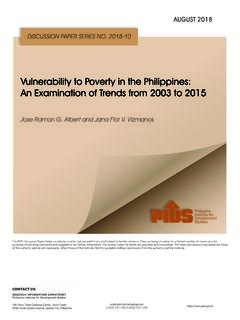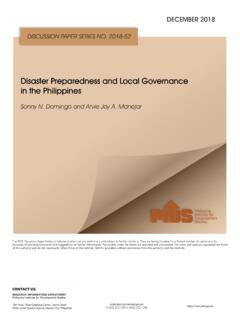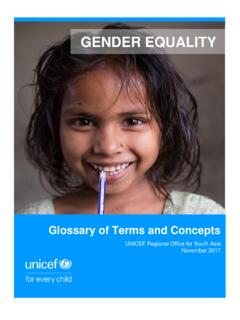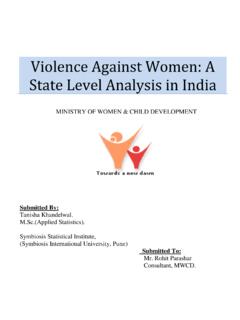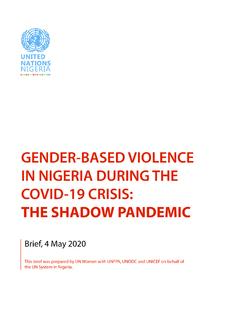Transcription of Sustainable Development Goal 5: How Does the Philippines ...
1 Philippine Institute for Development Studies Surian sa mga Pag-aaral Pangkaunlaran ng Pilipinas Sustainable Development Goal 5: How Does the Philippines Fare on Gender Equality? Clarissa C. David, Jose Ramon G. Albert, and Jana Flor V. Vizmanos DISCUSSION PAPER SERIES NO. 2017-45. The PIDS Discussion Paper Series constitutes studies that are preliminary and subject to further revisions. They are being circulated in a limited number of copies only for purposes of soliciting comments and suggestions for further refinements. The studies under the Series are unedited and unreviewed. The views and opinions expressed are those of the author(s) and do not necessarily reflect those of the Institute. Not for quotation without permission from the author(s) and the Institute. December 2017. For comments, suggestions or further inquiries please contact: The Research Information Staff, Philippine Institute for Development Studies 18th Floor, Three Cyberpod Centris North Tower, EDSA corner Quezon Avenue, 1100 Quezon City, Philippines Tel Numbers: (63-2) 3721291 and 3721292; E-mail: Or visit our website at Sustainable Development Goal 5: How Does the Philippines Fare on Gender Equality?
2 By Clarissa C. David, Jose Ramon G. Albert and Jana Flor V. Vizmanos 1. The global goal to attain gender equality, including ending all forms of discrimination against women and girls, and ensuring their safety, is central to the achievement of the Sustainable Development Goals. Its attainment means that every person, regardless of sex, is empowered to reach their full potential. This entails having both men and women being given equal opportunities to education, paid employment, and real decision-making power whether in private, or public sectors. This paper discusses how the country fares in several gender and gender-related indicators that can be used to monitor progress toward gender equality and women's empowerment. It provides an overview of the current situation in areas such as equality of human capabilities, equality of economic opportunity, equality in political voice and leadership, and the safety of women and girls. The paper also identifies priorities for public policy while seeking new directions in a number of transformational issues to attain gender equality and women's empowerment in the country.
3 Key Words: gender, gender equality, equality of human capabilities, women's economic empowerment, women's political voice and leadership, violence against women (and girls). 1 The first author is a professor at the UP College of Mass Communication, while the second and third authors are senior research fellow and research assistant, respectively, of the Philippine Institute for Development Studies (PIDS). The views expressed here are the author's own. 1. 1. Introduction The Philippines , together with 192 other UN member states, committed to attaining the Sustainable Development Goals (SDGs) by 2030. The SDGs are a set of 17 goals to pursue a total of 169 targets by 2030 to eliminate poverty, protect the planet, and ensure peace and prosperity for all. Among the 17 global goals is SDG5, a global goal to achieve gender quality and empower all women and girls . There are 9 targets and fourteen indicators for SDG5(Box 1). Each of the SDG5 targets seeks to pursue the main goal of real and sustained gender equality in all aspects of women and girls' lives.
4 The targets include ending discrimination, eliminating violence against women and girls, eliminating early and forced marriage, ensuring equal participation and opportunities for leadership, and universal access to sexual and reproductive rights. Box 1. Targets for SDG5 ( Achieve gender equality and empower all women and girls ). and Indicators for Monitoring SDG5 Targets Target indicator End all forms of discrimination against all women Whether or not legal frameworks are in place to promote, enforce and girls everywhere and monitor equality and non-discrimination on the basis of sex Eliminate all forms of violence against all women Proportion of ever-partnered women and girls aged 15 years and and girls in the public and private spheres, including older subjected to physical, sexual or psychological violence by a trafficking and sexual and other types of exploitation current or former intimate partner in the previous 12 months, by form of violence and by age Proportion of women and girls aged 15 years and older subjected to sexual violence by persons other than an intimate partner in the previous 12 months, by age and place of occurrence Eliminate all harmful practices, such as child.
5 Early Proportion of women aged 20 24 years who were married or in a and forced marriage and female genital mutilation union before age 15 and before age 18. Proportion of girls and women aged 15 49 years who have undergone female genital mutilation/cutting, by age Recognize and value unpaid care and domestic work Proportion of time spent on unpaid domestic and care work, by through the provision of public services, infrastructure sex, age and location and social protection policies and the promotion of shared responsibility within the household and the family as nationally appropriate Ensure women's full and effective participation and Proportion of seats held by women in (a) national parliaments equal opportunities for leadership at all levels of and (b) local governments decision-making in political, economic and public life Proportion of women in managerial positions Ensure universal access to sexual and reproductive Proportion of women aged 15 49 years who make their own health and reproductive rights as agreed in accordance informed decisions regarding sexual relations, contraceptive use and with the Programme of Action of the International reproductive health care Conference on Population and Development and the Number of countries with laws and regulations that guarantee full Beijing Platform for Action and the outcome documents and equal access to women and men aged 15 years and older to sexual of their review conferences and reproductive health care, information and education Undertake reforms to give women equal rights to (a) Proportion of total agricultural population with ownership or economic resources, as well as access to ownership and secure rights over agricultural land, by sex.
6 And (b) share of women control over land and other forms of property, financial among owners or rights-bearers of agricultural land, by type of tenure services, inheritance and natural resources, in Proportion of countries where the legal framework (including accordance with national laws customary law) guarantees women's equal rights to land ownership and/or control Enhance the use of enabling technology, in Proportion of individuals who own a mobile telephone, by sex particular information and communications technology, to promote the empowerment of women Adopt and strengthen sound policies and enforceable Proportion of countries with systems to track and make public legislation for the promotion of gender equality and the allocations for gender equality and women's empowerment empowerment of all women and girls at all levels Many of the SDG5 targets is composed of multiple indicators. For example, for SDG to ensure women's full participation in leadership at all levels of decision-making in political, economic, and public life, the indicators are the proportion of seats held by women in national parliaments and local governments ( indicator ), and the proportion of women in managerial positions 2.
7 ( indicator ). Of these 2 indicators, only the second belongs to the so-called Tier I2. indicators which have a clear and established methodology and for which data are regularly collected by many countries, while the first indicator has only the first component that is Tier I. (with the second component having an unclear methodology thus far). Even before the adoption of the SDGs, commitments for action to achieve gender equality were established in numerous UN resolutions and international instruments dealing with human rights, including the rights of women and girls. Particularly significant are the UN General Assembly (UNGA) Resolution 217A of 1948 (also called the Universal Declaration on Human Rights), the International Covenant on Civil and Political Rights (ICCPR) and the International Covenant on Economic and Social Rights (ICESR) (both adopted by the UNGA in 1966, entered into force 1976) which together constitute the International Bill of Human Rights and the Convention on the Elimination of All Forms of Discrimination Against Women (CEDAW) (adopted in 1979, entered into force 1981).
8 Building on the agenda in CEDAW and other human rights instruments, the 1995 Fourth World Conference on Women mobilized support for gender equality across government, business, civil society and the Development community. The Beijing Declaration and Platform for Action adopted at this conference called for strategic action across 12 areas, viz., 1) The burden of poverty and inequality on women;. 2) Inequalities, inadequacies, and unequal access to education and training;. 3) Inequalities, inadequacies, and unequal access to health care and related services;. 4) Violence against women;. 5) Effects of conflict on women;. 6) Inequality of economic structures and policies, in all forms of productive activities and access to resources;. 7) Inequality between men and women in the sharing of power and decision-making;. 8) Inefficient mechanisms to promote the advancement of women;. 9) Lack of respect for and inadequate promotion and protection of the human rights of women;. 10) Stereotyping of women and inequality in women's access to and participation in communications systems, especially in the media.
9 11) Gender inequalities in the management of natural resources and safeguarding the environment; and 12) Persistent discrimination against and violation of the rights of the girl child. Since the adoption of the Beijing Platform for Action in 1995, gender equality concerns have been elaborated and interpreted in various global, regional, and national advocacy documents, plans of action, and progress reports. A subset of the international agenda for action laid out by CEDAW and the Beijing Platform for Action has even been incorporated in the Millennium 2 The current set of global indicators for monitoring the SDGs are grouped into three tiers Tier 1, Tier 2 and Tier 3. Indicators classified as Tier 1 have a clear and established methodology and data are regularly collected by many countries. Tier 2 indicators are those that have an established methodology but are not regularly collected by many countries. Tier 3 indicators do not have established standards and/or estimation methodology.
10 Of the 14 indicators for SDG5, 2 (namely, Indicators , and ). belong to Tier I indicators; 7 ( , , , , , , ,) are Tier II indicators; 4 (viz., Indicators , , , and ) are categorized under Tier III indicators and 1 indicator (namely indicator ) has multiple tiers since different components of these indicators are classified into different tiers. 3. Development Goals (MDGs)3, the predecessor to the SDGs. The MDGs, a set of 8 global goals, was supported by 21 specific, time-bound, and quantifiable targets for 2015 across 60 statistical indicators using 1990 baseline data, with a target date of 2015. The MDGs though were somewhat compartmentalized, with no explicit recognition of linkages and interdependence among the goals. MDG3 on promoting gender equality and empowerment of women, had targets in three areas, education (as indicated by the ratio of girls to boys in school enrollment);. employment (as indicated by the share of women in non-agricultural wage employment); and political participation (as indicated by the share of women in seats in national parliaments).


